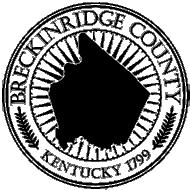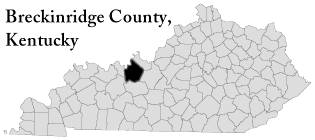 |
USGenWeb Archives Project Breckinridge County, Kentucky |
 |
 |
 |
 |
 |
USGenWeb Archives Project Breckinridge County, Kentucky |
 |
 |
 |
 |
THESE
ARCHIVES BUILT BY YOUR
CONTRIBUTIONS.
PLEASE CONTRIBUTE TODAY!
New
Easy to use Submission
Forms!
This Page Updated Monday, 11-Apr-2022 20:27:44 EDT
| BRECKINRIDGE COUNTY, KENTUCKY |
| AREA COMMUNTIES OF THE PAST AND PRESENT |
| GLEN DEAN |
In a peaceful little valley about ten miles southwest of
Hardinsburg lies one of the most picturesque and noteworthy
communities to
be found anywhere in our Commonwealth.
Daniels Creek
meanders right through the center of the little town, its water
always being crystal
clear, except immediately after a heavy rain.
Since 1800,
this little creek has furnished amusement for little boys,
wonderment and a scientific
laboratory for probing adolescent minds, a mirror of enchantment
for lovers, and an everlasting abundance of clear water for the
farmers’ livestock.
All of the hills
rising from the creek bottoms are thickly
wooded with white oak, black oak, sugar tree, and many of the
other valuable timbers.
This little creek
valley runs for a distance of about six
miles to where it empties into Rough River some two miles below
the new Rough River
Dam. This total
valley, together with the upland farms on
either side, constitute the community of Glen Dean.
The residents of Glen Dean, from the very earliest of its
existence have put a great emphasis upon education and always
keeping it well
balanced with their religious life.
The old Goshen Baptist
Church of Glen Dean was one of the first places of Christian
worship in Breckinridge
County. It was
located on Long Lick Creek, on the old Uncle
Ike Owen place, on what is now Leroy Jarboe’s farm. Realizing
the
necessity of Christian training, a group of settlers in the
community met in 1808, and built the first church.
Goshen was truly a suitable name.
It came from the Biblical
community in Egypt. It
was located in the Easter section
of the Nile Delta where the Isralites were planted.
The
word means, “A land of peace and plenty”.
The first of these settlers to invade this section of the
wilderness in our county were the Deans, Moormans, Owens, and
Robertsons. These
were well-to-do families in the areas
from which they came, bringing with them many slaves.
James Moorman, the first to come to our county in 1800,
was born
in Campbell County, Virginia in 1776, the year of the signing of
the Declaration of Independence. He
was sheriff in Kentucky
for many years.
Summers Dean was the first member of that family to come
to the
Glen Dean community. He
was a native of Mercer County,
Kentucky, born in 1800 on April Fool’s Day.
Thomas Owen, of Welsh descent, was born in North Carolina
and
migrated to Breckinridge County about the turn of the century.
William Robertson was born in Virginia.
He came to
Breckinridge County in the early eighteen hundreds, when he was
eleven years old. He
married Miss Sally Moorman of Glen
Dean. Thus began
the Robertson clan.
Whether it be the inherited traits of their forebearers or
someone special elements found in the soil, I do not know, but
for some reason
this community has produced more than its share of good brains
and great characters. Doctors,
lawyers, politicians,
statesmen, and soldiers are
among the products of this community.
Glen Dean was named in honor of probably the largest land
owner
in the county at that time—a Mr. William Johnson Dean.
William Johnson
Dean was the brother of Henry Dean who
married Miss Sarah McDonald. She,
it was, who was dropping
corn behind
Colonel William Hardin at Hardins Fort when he was shot by the
Indians, and threw him on his horse, and saved his scalp by
getting him to the safety of the Fort.
Prior to 1891, which year the railroad was completed
through the
valley, Glen Dean was just another name, but at this time it grew
rapidly
as a boom town, and became the shipping center of the area.
Before the days of the “Iron Horse”
these farmers, most
of whom were wealthy, were compelled to travel either to
Cloverport or Hardinsburg
to dispose of their farm commodities and to buy the necessities
of life. They never
seemed to realize the inconvenience
attached to this sort of routine.
But with the
shrill of the locomotive and the puff of the
steam through the glen of Daniels Creek, new ideas were generated
in the bosoms of those who
set about to build a town of prominence at Glen Dean.
The Hon. D. C. Moorman was the first chief officer of the
town,
being magistrate, while Wm. Owen was the first constable.
There were many railroad employees and lumbermen working
for the
Dean Tie Company, who used Glen Dean as a trade center.
As
a result storehouses and residences began to spring up like
magic.
Joe Mattingly has the distinction of building the first
business
place in Glen Dean. He
built and was proprietor of the
celebrated hotel known
as the Glendean House.
W. C. Moorman and C. Beeler were the first Glen Dean
merchants to
display their wares to the public.
Their primitive
storehouse was a
box car, so divided as to serve for a public store, post office,
and a city hall.
By 1901, ten years after the coming of the railroad, Glen
Dean
had outgrown her class and it was necessary that she be
incorporated into a city of
the sixth class with a board of town trustees, a police judge,
and a marshall. The
town board consisted of W. C. Moorman,
Joe Mattingly, I. H. Deweese,
T. W. Mattingly and J. M. Howard.
Perry Hoskins was the
police judge, while the conduct of the city was under the
jurisdiction of Marshall Dan Goodman.
The town plan was laid out with three streets running the
length
of it: Main Street,
Johnson Avenue, and Mary’s Avenue,
the last two took
their names from Mr. and Mrs. Johnson Dean, who gave the land for
the town. On Main
Street was located the New Bank of Glen
Dean. There were
two mercantile houses owned by Mr. C.
Beeler, and Mrs. I. H. Deweese and W. C. Moorman, Mr. Joe
Mattingly’s Hotel and the drugstore of
Dr. Dempster. There
were also in the eastern end of Main,
several residences. At
the extreme lower end of Main Street
was located the large tobacco
factory built by John Dean, son of Johnson Dean.
After his
death Robert Moorman and Jess Howard operated it for the American
Tobacco Company.
Later it was
rented to William Hensley of Hardinsburg.
The Utopia School and several residences were on Johnson
Avenue.
Utopia School was built in 1893.
It consisted of three
large rooms, two on the first floor, both used as classrooms.
The large room
on the second floor was used as a town hall.
Professor Frank Lyons was the first principal. Later Mr.
Joel Pile, who in 1902, became the superintendent of county
schools, was principal
with Miss Irene Board and Mary Moorman as teachers.
For
several years there was a total enrollment of 224 with an average
attendance of 100.
The jail, or calaboose, as it was called, was located
directly in
front of Ernest Robertson’s store.
Dave Moorman, son of Jess Moorman and grandson of James
Moorman,
the original settler, server our county in legislature in 1901,
and is accredited
with successfully defeating a bill to divide Breckinridge County,
making Hansen County of the eastern half.
Mr. Moorman was
also president of the Bank of
Glen Dean which lasted only nine years.
Jess Moorman, Dave’s father sometimes known as
Devil Jess,
rode a horse from Glen Dean to Virginia where he purchased a
Negro slave woman
and her five sons for the sum of $2, 700.00.
The woman was
old and he paid $200 for her and $500 each of the five boys.
He rode his horse through
Cumberland Gap and walked the slaves home.
Ernest and Vick Robertson were engage in cattle and
tobacco
business in Glen Dean for years. The
re-dried annually,
about 350,000 lbs. of
Burley for the Louisville Markets.
They also bought and
sold some $150,000 worth of cattle and work stock.
Ernest Robertson ran a general store in Glen Dean for
forty years
until he retired. For
several years his store made in the
neighborhood of
$40,000 per year.
In the early years of this community probably the most
important
man in town, other than the preacher and the doctor, was the
village blacksmith.
When a piece of machinery was broken it was the blacksmith
who
repaired it, or if beyond the point of repairing he made a new
one.
J. A. Mattingly was one of the better blacksmiths in the
state.
Mr. Mattingly ran more than a blacksmith shop, he operated
a
manufacturing
plant. In addition
to sharpening plow points and colters,
and the many other mending jobs from wheelbarrows to threshing
machines, he annually turned out
some sixty to seventy plows and from ten to fifteen wagons.
Some of Mr. Mattingly’s wagons and plows lasted
longer than
the blacksmithing profession itself.
Today a blacksmith
shop may be found only in history.
Henry Wadsworth Longfellow in his poem, “The
Village
Blacksmith,” tried to show the importance of this man to the
total well-being of the community.
Ironically enough, the
old High Wheel wagon, the Blacksmith Shop, and the Chestnut tree,
faded from the picture at the same time.
Dr. R. T. Dempster and his son, P. E. Dempster migrated
from
Canada to the Glen Dean Community where he and his son practiced
for years,
alleviating human suffering. They
had their own drug store
where they always kept on hand, a supply of any needed drug.
The Dean Tie Company came into being in 1891, when the
railroad
made its maiden trip down Daniels Glen.
J. M. Howard was
manager of
the firm and shipped an average of about 1, 400 car loads of ties
and lumber annually. Many
of the ties were sawed at or near
Glen Dean but many more were
hauled for a distance of 10 to 15 miles on wagons.
A
majority of these ties were hewn with a broadax.
The
standard cross-tie was 7 in. x 9 in. x 8 ft.
The Dean Tie Company brought a lot of money into the south
end of
our county for many years. Unfortunately
very little care
was taken in cutting
the trees, and one of our greatest natural resources was wantonly
wasted.
This little community reached beyond the boundary of our
county
or state. Mr.
Moorman Robertson, son of Charles Robertson,
was converted
in the old Goshen Baptist Church.
He, as a young man, was a
Breckinridge County school teacher and his salary was $15.00 per
month. He taught
only
one school, then went to China as a missionary.
As was previously mentioned, the people of Glen Dean kept
their
business life well balanced with their religion.
In the
very earliest days of the
community, prior to 1808, the people met in different homes and
held their religious services.
It was not until 1808, that there was a church building in
which
to worship. The
Pioneer Goshen Church, on the old Ike Owen
farm, on Long
Lick Creek, served as the center of religious activities until it
was moved to a new location near the old Black Lick Bridge, on
the Johnson Dean farm which Mrs. Dorsey
Brown now owns.
This church is often referred to as the “Old
Goshen
Church,” as it is still remembered by some of the older
residents of the community. In
1900, it was decided to
remove the church to Glen Dean to its present location.
In
1904, the first services were held in the New Glen Dean Goshen
Baptist
Church, which stands there today with a sizeable membership.
A Methodist Church was built in the town, which lasted for
many
years. The church
was built in 1903, and was in continual
service until 1956,
when it was discontinued and its members moved to Hardinsburg.
The family of William Johnson Dean dates back to the year
1000.
The Dean family came from Denmark to Scotland, to England
and
Stephen Dean was one of the pilgrims who came on the Mayflower,
and settled
at Plymouth. From
there he followed civilization westward.
William Johnson Dean was the son of Summers Dean and Mrs.
Amanda
(Robertson) Dean of Virginia. He
owned 1700 acres of good
crop
land lying along Daniels Creek, -- so named because a Negro man,
named Daniel, drowning in its waters.
He donated the
section of the valley to the town that
bears his name, Glen Dean. It
was originally spelled
“Glendean”.
Mr. William Johnson Dean was one of the outstanding
farmers and
stockmen of Breckinridge County.
William Johnson Dean had nine (9) children: Gordon Summers,
John Allen, William John, Mary Elizabeth, Amanda Robertson, Jimmy
Lee,
Margaret Wickliffe, and Charles Wickliffe.
Judge John Allen Dean was a distinguished lawyer and
served for a
number of years as referee in the Bankruptcy court of the Western
district
of Kentucky and was located at Owensboro, Kentucky.
Margaret Wickliffe married Charles L. Cornwell.
Charles L. Cornwell was the chief engineer for the
railroad when
its tracks were being laid through the village.
It was
there he met Miss
Margaret, and to this union was born one son, Dean Cornwell.
Dean Cornwell is one of the outstanding painters and
illustrators
of the United States. Some
of his outstanding works are his
illustrations of
the “City of the Great King”, “Man of
Galilee”.
His drawings in the main rotunda of the Los Angeles Public
Library and the decoration of the “Dame and Two
Lunettes”, in the Lincoln Memorial
Building, Redlands, California, and the murals in the Raliegh
room of the Hotel Warwick in New York City.
In 1937, he did the murals for the new courthouse in
Nashville,
Tennessee, and also the murals for the new Government Pot Office
in Morgantown,
North Carolina.
The over-all community of Glen Dean will continue to live
and
make history, but since the county roads have improved and trucks
have taken over
most of the shipping, cars have drained the passenger service and
in 1941, the railroad pulled out of Glen Dean completely. The
town is only a lazy shell
of its former self. The
school consolidated with the
McQuady school, there is no doctor, no tobacco warehouse, no
hotel and no drugstore. It
lies at the end of our
county’s paved road, a victim of history, with Daniels Creek
and its clear bubbling water, the lone, unchanged survivor of a
by-gone period.